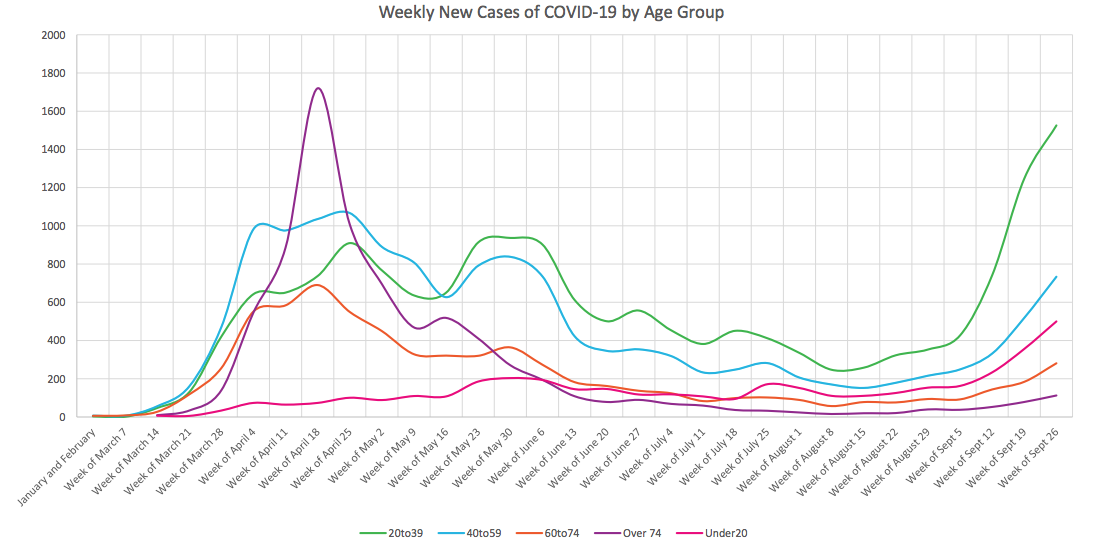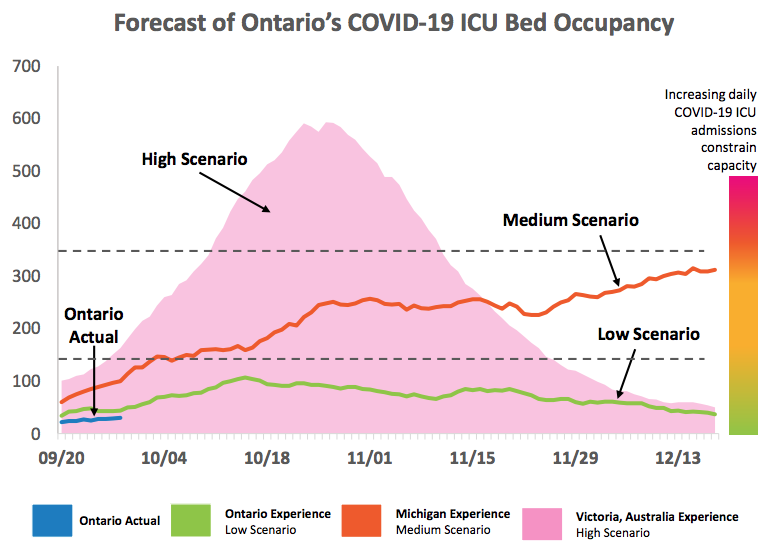TORONTO – New projections show Ontario could see upwards of 1,000 new COVID-19 cases per day by mid-October.
The data, released by the province on Sept. 30, also shows an increase in cases across all age groups – not just in young people, as seen over the past month.
And across Ontario, coronavirus cases are doubling every ten to 12 days.
“If things grow as we’re anticipating, we will see a dramatic increase in the number of cases,” said Dr. Adalsteinn Brown, dean of the public health school at the University of Toronto, at a Sept. 30 press conference.
He called over 1,000 COVID-19 cases daily within the first half of October “a remarkably high surge.”
Age groups
Since the first week of September, the data shows an increase in cases across the board, with the most significant increase in the 20 to 39 age group.
Whether it’s because young people are spreading the disease or older adults aren’t taking precautions, or a combination, there is currently a “spill over” in new cases in older adults, Brown noted.
“We’re seeing growth across all age groups,” he said.

Provincial data shows COVID-19 cases are on the rise across all age groups since early September, most notably among the 20 to 39 age group.
Brown advised that if those in the older age groups don’t take precautions it could lead to a strain on the health care system and higher death rates.
Dr. David Williams, Ontario’s Chief Medical Officer of Health, echoed that sentiment.
“We can’t be cavalier about it,” Williams said of older adults.
He noted those individuals are putting themselves “at great peril” if they don’t wear masks and take other precautions.
Officials also noted that increasing cases in the community pose a risk to those in congregate settings, such as nursing homes, something Ontarians witnessed during the first wave.
ICU cases
The new modelling identifies intensive care unit (ICU) capacity as an important measure of the pandemic’s impact on the health care system.
The data shows that as long as there are less than 150 patients in ICUs across the province (the Sept. 30 total is 35), officials will be able to maintain non-COVID capacity and all scheduled surgeries.
When the total exceeds 150 it becomes more difficult, officials say, and when it reaches 350 “it becomes impossible.”

Health officials are using three possible scenarios to predict the impact the second wave of COVID-19 could have on ICU beds across the province.
Ontario officials used three jurisdictions to create a range of scenarios to predict the pandemic’s impact on ICU beds.
The low scenario, based on Ontario’s first wave but with a younger population affected, would see less than 100 people in ICU beds by November.
The medium scenario, based on Michigan’s experience with a mixture of old and young individuals affected, would result in about 250 people in ICUs.
Under the high scenario, based on the experience in Australia with an older and more vulnerable affected population, ICU admissions would surpass 500.
What can we do?
Officials noted the new modelling does not take into account recent moves by the province to lower gathering limits, place restrictions on bars and restaurants serving alcohol, and close strip clubs.
Williams warned that Ontarians must follow those rules, in addition to wearing masks, keeping 2m apart from others, washing hands frequently and staying at home when sick.
“People have to take these recommendations seriously,” said Williams.
“People have to stay to the task … everybody has to do their part.”
With 625 new cases reported on Sept. 30, provincial officials have not ruled out further restrictions and measures to help stop the spread during the second wave.
Brown noted the first wave proved that “the stricter the measures … the sharper the decline [in cases] following that.”
To date there have been 51,710 cases of COVID-19 in Ontario, 43,907 resolved cases and 2,848 deaths.




